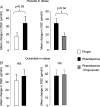Adrenaline but not noradrenaline is a determinant of exercise-induced lipid mobilization in human subcutaneous adipose tissue
- PMID: 19417097
- PMCID: PMC2727046
- DOI: 10.1113/jphysiol.2009.168906
Adrenaline but not noradrenaline is a determinant of exercise-induced lipid mobilization in human subcutaneous adipose tissue
Abstract
The relative contribution of noradrenaline (norepinephrine) and adrenaline (epinephrine) in the control of lipid mobilization in subcutaneous adipose tissue (SCAT) during exercise was evaluated in men treated with a somatostatin analogue, octreotide. Eight lean and eight obese young men matched for age and physical fitness performed 60 min exercise bouts at 50% of their maximal oxygen consumption on two occasions: (1) during i.v. infusion of octreotide, and (2) during placebo infusion. Lipolysis and local blood flow changes in SCAT were evaluated using in situ microdialysis. Infusion of octreotide suppressed plasma insulin and growth hormone levels at rest and during exercise. It blocked the exercise-induced increase in plasma adrenaline while that of noradrenaline was unchanged. Plasma natriuretic peptides (NPs) level was higher at rest and during exercise under octreotide infusion in lean men. Under placebo, no difference was found in the exercise-induced increase in glycerol between the probe perfused with Ringer solution alone and that with phentolamine (an alpha-adrenergic receptor antagonist) in lean subjects while a greater increase in glycerol was observed in the obese subjects. Under placebo, propranolol infusion in the probe containing phentolamine reduced by about 45% exercise-induced glycerol release; this effect was fully suppressed under octreotide infusion while noradrenaline was still elevated and exercise-induced lipid mobilization maintained in both lean and obese individuals. In conclusion, blockade of beta-adrenergic receptors during exercise performed during infusion of octreotide (blocking the exercise-induced rise in adrenaline but not that of noradrenaline) does not alter the exercise-induced lipolysis. This suggests that adrenaline is the main adrenergic agent contributing to exercise-induced lipolysis in SCAT. Moreover, it is the combined action of insulin suppression and NPs release which explains the lipolytic response which remains under octreotide after full local blockade of fat cell adrenergic receptors. For the moment, it is unknown if results apply specifically to SCAT and exercise only or if conclusions could be extended to all forms of lipolysis in humans.
Figures






References
-
- Alberti KG, Christensen NJ, Christensen SE, Hansen AP, Iversen J, Lundbaek K, Seyer-Hansen K, Orskov H. Inhibition of insulin secretion by somatostatin. Lancet. 1973;2:1299–1301. - PubMed
-
- Arner P. Catecholamine-induced lipolysis in obesity. Int J Obes Relat Metab Disord. 1999;23(Suppl. 1):10–13. - PubMed
-
- Arner P, Hellmér J, Hagström-Toft E, Bolinder J. Effect of phosphodiesterase inhibition with amrinone or theophylline on lipolysis and blood flow in human adipose tissue in vivo as measured with microdialysis. J Lipid Res. 1993;34:1737–1743. - PubMed
-
- Arner P, Kriegholm E, Engfeldt P. In situ studies of catecholamine-induced lipolysis in human adipose tissue using microdialysis. J Pharmacol Exp Ther. 1990a;254:284–288. - PubMed
Publication types
MeSH terms
Substances
LinkOut - more resources
Full Text Sources
Medical

